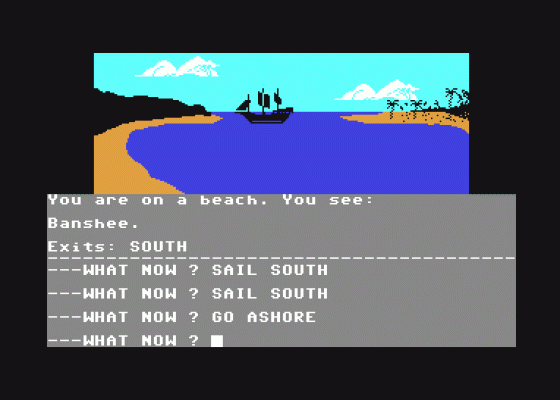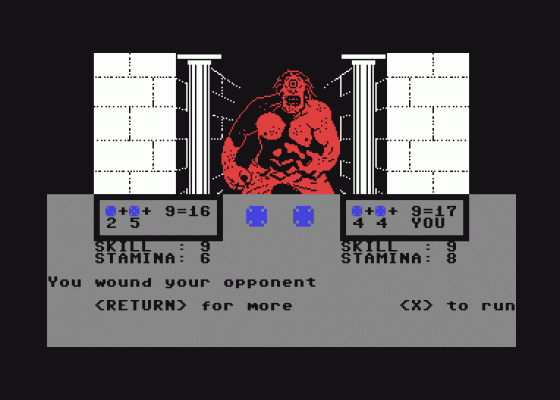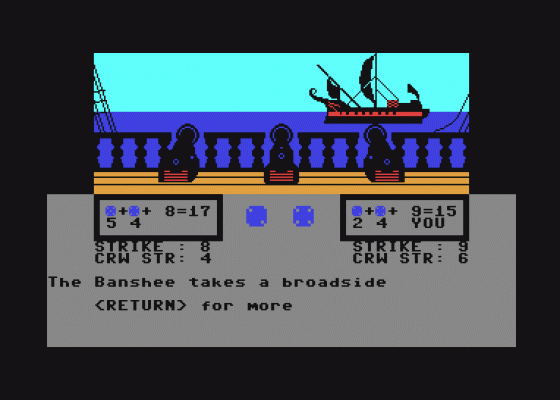
Zzap
 1st January 1986
1st January 1986
Categories: Review: Software
Publisher: Adventure International
Machine: Commodore 64
Published in Zzap #9
Seas Of Blood
Oh Boy, here's a really nasty game! For those of you who are fed up with always playing the good guy. Seas Of Blood gives you the chance to work out all that pent-up aggression by sailing around finding victims and killing them without mercy! Don't get too excited, though, because, chances are that you'll meet your match sooner or later and end up as shark-fodder.
Although it's been programmed by Brian Howarth and Mike Woodroffe of Gremlins and Robin Of Sherwood renown, this latest Adventure International release is largely founded on the work of Steve Jackson and Ian Livingstone. In case the names aren't familiar, these gems have brought the joys of man-to-man combat into living rooms all over the country with their fantasy books. The books use a dice system combined with hit points and experience to determine the outcome of lights, and the system has been adopted by the computer game.
In order to give you lots of opportunity for rolling the dice, Seas Of Blood puts you in the role of a blood-thirsty pirate captain on the Inland Sea who must retrieve twenty treasures and store them on a mountain-top in order to crack the game. You start off on board your ship and navigate the ocean blue using the command "Sail" followed by a direction.

Apart from the normal adventuring and exploring to be done, there's also a strategy element to the game, since you must keep an eye on the morale of your men and on your provisions if you are to avoid mutiny and ending up as shark-fodder.
Although AI claim there are 300 graphics locations in this game, I soon found himself sailing around in circles seeing nothing but vast, featureless expanses of ocean. In fact the game is not very easy to map unless you steadfastly stick to the coastline and first define the borders of the Inland Sea before attempting to cross it. While you're at sea, you occasionally come across merchant ships which you can attack and, if your 'crew strength' is greater than that of your opponent, you have a good chance of victory and adding to your treasure trove.
When you arrive on land, you will find new foes to conquer, and on these occasions the game takes on a rather more conventional adventure flavour, with hidden tombs, treasures and - of course - more victims ripe for the slaughter.

Movement on land can present problems. A number of Adventure International games still employ the old technique of requiring you to enter the command "Go" followed by a location or object - for example, "Go mountain". If you're not used to it this can be a bit unnerving - there are a number of locations that do not specify any exits at all, and entering a direction will get you a "Can't move in that direction" message. Just as you think you're stuck there forever, entering "Go Mountain", or something similar, gets you moving again.
This rather primitive syntax is, unfortunately, combined with another perennial AI habit of ignoring words that the program doesn't understand. This is downright confusing sometimes, particularly if the program has actually understood what you are saying and taken some action without telling you (as it sometimes does!).
However, the combat routines really do make up for all this, and a bit more besides. As soon as you 'attack' some poor unfortunate (or they attack you) a pair of dice appear on the screen and start spinning away, and your life hangs in the balance for the next few seconds as you attempt to throw a better score than your opponent.
Your 'hit' points are added to your score (as are your enemy's), but these tend to diminish as you progress in the game, whereas the opposition always seems to be fresh as a daisy! Sooner or later (sooner in my case) you encounter someone who really gives you a hammering, and from then on it's only a matter of time before you meet your maker.
I have my reservations about Adventure International games - they look great and have lots of locations, but the parsing is always a bit primitive and there really aren't any outstanding programming features - interactive characters, for example, or interrupt-driven events. However, the Fighting Fantasy team seem to have done for the company very much what Scott Adams did with the Marvel Superheroes - inject a new burst of energy that has resulted in an above average game. Much as I deplore bloodshed, I can't wait to get back to the keyboard to knock the stuffing out of another over-fed merchant!








